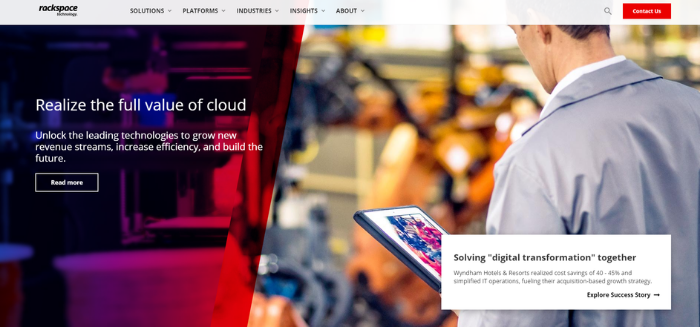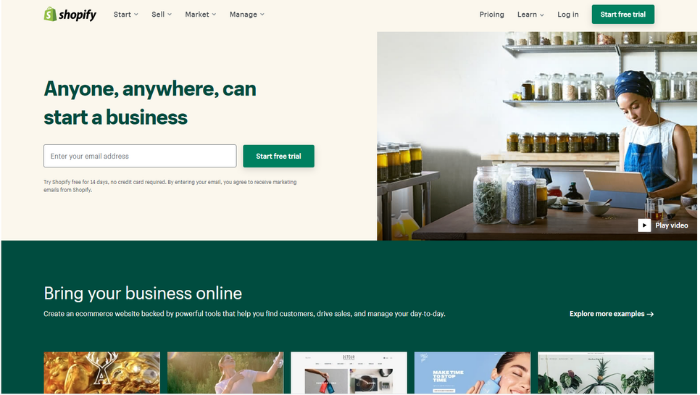What’s IaaS? How does it have an effect on your ecommerce web site?
Cloud computing has gained the upper hand in recent years and offers companies and users many opportunities. The terminology can be a bit complex, however, and as with many IT-related things, there are a lot of acronyms to be thrown around.
IaaS is an acronym you might have seen, but what does it mean and how can it affect your ecommerce store?
Along with PaaS and SaaS, these acronyms describe the different ways businesses can use cloud technology, and choosing the right one for your ecommerce business can make a world of difference.
What IaaS means for your website
If you're building a website today, there's a good chance it's hosted in the cloud. Very few companies have their own servers. Instead, they rely on third party companies to take care of many elements of their online presence.
The distinction between IaaS (infrastructure as a service), PaaS (platform as a service), and SaaS (software as a service) is critical as it determines the level of control you have over your website.
For some businesses, especially those with large, complex ecommerce websites, infrastructure as a service is likely the best option because it allows greater flexibility and control.
More and more companies are moving their infrastructure to the cloud every day. It is important that they understand how to best use these to get the best results. IaaS, SaaS, and PaaS just describe how you use the cloud – and every company will do it slightly differently.
Today 90% of companies use the cloud. According to some estimates, cloud data centers will soon handle 94% of workloads.
Therefore, understanding what to invest in and how to get the most out of cloud computing is critical for businesses.
Cloud Computing: IaaS Vs. SaaS Vs. PaaS Vs. Serverless Computing
When it comes to cloud computing, it can seem like you're constantly bombarded by acronyms. In fact, IaaS, SaaS, and PaaS are useful distinctions that can help you run your ecommerce store more efficiently.
Cloud computing is about allowing you to take care of the parts that you are good at and leave the rest to the professionals. Every company has different capabilities, so the cloud is used in different ways.
For example, in a bootstrap store, the owner can build the entire website with limited resources. In that case, they may just want to focus on the basics of building a functional, engaging business, leaving things like runtime, servers, and storage to an outside company.
On the other hand, a large multinational company can have a multitude of developers and IT professionals who are able to handle more complex functions.
IaaS, SaaS, PaaS and serverless computing offer companies the flexibility to control different parts of the cloud.
IaaS
IaaS is the cloud-based alternative for maintaining the infrastructure on site. In the past, companies would have had their own data centers. Today it can be much more efficient to use the cloud.
Maintaining your own IT infrastructure can be costly, and most organizations don't have the skills to do this without the help of an outside company. With IaaS, companies don't have to maintain their infrastructure. Instead, they pay to use a third-party server, network technology, storage, and data center.
For companies running ecommerce websites, this means they don't have to worry about the highly technical aspects of running a web application or invest in expensive infrastructure. Instead, they pay to access infrastructure through the cloud through companies like AWS, IBM, and Rackspace.

While things like storage and networking are done by a third party, with this option you are still responsible for the following:
- Applications
- Data
- running time
- Middleware
- O / S.
This is important for larger companies as it gives them much more control over how they run their website while offering a scalable, cost-effective solution.
PaaS
Like IaaS, PaaS leaves key components such as physical computing, networking, storage and virtualization to the provider. With PaaS, however, you also outsource runtime, middleware and operating system.
As the name suggests, PaaS gives you the platform to develop, run and manage applications without having to worry about the underlying infrastructure.
This means you have less to worry about and less technical knowledge, but it also means you have less control over how you run your ecommerce website than with IaaS.
Whichever service you choose, there is a tradeoff between convenience and control. With PaaS you get a middle ground between IaaS and SaaS. While much of the service is managed, you are still in control of applications and data, which can be useful for certain businesses.
This makes PaaS providers like Magento Commerce Cloud and Bluehost particularly popular with developers as they offer everything they need to build new applications without having to invest in expensive infrastructure and operating platforms.
Instead, they pay for what they need so they can focus more on building the applications.

Serverless computing
Companies are constantly looking for the most efficient ways to use the cloud. Another option is serverless computing.
Serverless computing is very similar to PaaS, but with a few minor differences.
One of the main differences between serverless computing and PaaS is that serverless is event driven. You only pay for what you use, while with PaaS you pay a monthly fee and have a limit on usage.
Serverless computing automatically scales with your business, but you give up control. However, it allows you to be extremely flexible, save costs while getting great performance.
This is an ideal option for fast growing ecommerce websites or those creating viral content that can lead to massive increases in traffic.
SaaS
For many people, SaaS is the fastest and easiest way to set up an ecommerce store. With providers like Shopify, you use third-party platforms and apps to quickly build a functional store.

Everything is done for you and all you have to do is upload your own products and create your marketing content.
The obvious benefit of this is convenience. Not everyone looking to set up an ecommerce store has IT expertise, and SaaS means it is not required. Instead of focusing on networking and hosting, all they have to do is focus on building their website and creating the content that will help them sell.
SaaS applications are very common on the Internet. Not only are there many SaaS applications that users can use to run their e-commerce businesses, but software like Microsoft 365, Google Cloud, and HubSpot are examples of SaaS as well.
The downside to ecommerce stores powered by SaaS is that their options are limited. If you have a Shopify business, you must operate within the limits set by that third party. When you run your business through IaaS or PaaS, there are fewer restrictions, so you have more control over your business.
How can IaaS affect your ecommerce website?
Cloud computing has made it a lot easier to build an e-commerce site. You no longer have to invest in expensive hardware, but can pay for access to the infrastructure as required.
This opened up e-commerce to a wide variety of people. With SaaS, no IT skills are required to build a competitive business. However, there are limitations associated with simply creating and managing a business through SaaS.
Many companies have the skills to handle the more technical aspects of running an ecommerce website and want to get the most out of those skills without building their infrastructure. IaaS is the perfect option for these businesses as it enables them to strike a profitable balance.
These companies can leverage and scale the infrastructure as their business grows and shrinks.
With IaaS you have maximum control over your e-commerce shop, so that you can make optimal use of your creative and IT skills without having to set up the infrastructure yourself.
How to Use IaaS for Your Ecommerce Business
One of the most important things about choosing between IaaS, PaaS, and SaaS is understanding the skills and resources that are available to you. If you are new to web application building and development, IaaS is not the best option for you and it may be better to consider a SaaS option.
Once you are confident that you can use IaaS to create and manage a high-level business, the next step is to understand your needs. There are many different IaaS providers and many different packages to choose from.
Every company is different and has different requirements. When choosing a provider, consider the following questions:
- What level of access and customization do you need?
- How flexible can the provider be?
- How will the provider deal with changing regulations?
- How much does it cost you
- What level of security is offered?
The whole idea of "as a service" is that you pay for the parts you need and so are free to take care of the parts you can handle. To get the most out of this concept, you need to have a clear picture of where your skills lie and how your provider can do the rest.
IaaS tools
When choosing an IaaS package, you need to take the time to find the package that best suits your business needs. There are many different options, and choosing the right tools can make all the difference for your business:
- Amazon EC2
- Google Compute Engine
- Digital ocean droplets
- Hostwinds
- Alibaba Elastic Compute Service
- IBM Cloud Private
- IONOS cloud
- Azure Linux virtual machines
- Rackspace technology
- Open stack
As you can see, there are many different options and this is only a small selection. The important thing is that you get the services your business needs without paying for resources that you don't pay for.
It may take a little extra research to unleash the true power of IaaS for your business, but it's worth it in the long run.
Conclusion
There are many different ways to run an ecommerce store. Using the cloud plays an important role when setting up or expanding your shop.
On-site infrastructure maintenance can be expensive and time-consuming. This is not absolutely necessary with modern cloud products.
The bigger question is: what do you need from the cloud?
For large ecommerce websites with tons of resources, infrastructure as a service is often the best way to go. This gives better control of your site than PaaS or SaaS options and is a cost effective way to scale your business.
When you make good use of the cloud, you can maximize the profitability of your business. Hence, it is important to make the right choice.
How does your e-commerce shop use the cloud?

See How my agency can drive Firmly Amounts of traffic on your website
- SEO – Unlock massive amounts of SEO traffic. See real results.
- Content Marketing – Our team creates epic content that is shared, links accessed and visitors drawn.
- Paid media – effective paid strategies with a clear ROI.
Book a call
